6/26/2001 update: During the second of two nights of very heavy rain, the swift nest and its five nestlings fell approximately 25 ft to the bottom of the chimney. The next morning, June 24, the nestlings were retrieved from the basement flue opening. One did not survive the fall, probably suffering a broken neck or head injury. The other four seemed unharmed but weak. The adults were not dropping down to the bottom of the chimney to care for them. Perhaps, like swallows, they recognize their own young at this early stage only by the precise location of the nest.
Sunday morning, when the nestlings were discovered, a nest replacement was hastily fabricated from a plastic flower pot bolted to a 10 ft section of 3/4" pvc pipe. The bottom was raised to 1 1/2" with a block of wood covered with pine needles. I was hoping that the adults would hang from the rim of the pot to feed the young. The nestlings were back in their original location at 9am Sunday, however, the adult swifts had written off the nesting and did not return to the chimney until dusk. When they discovered that their nestlings had been magically ressurected, they immediately went to the pot and two nestlings were fed one time. However, it was already too dark for them to hunt, so after 24 hours with no food, the nestlings had to wait another ten hours until daybreak Monday morning for feeding to resume.
Monday morning it became obvious that the adults were having a great deal of trouble reaching the young. The nesting material had worked to the side and the nest was now over 2" deep. Most feeding attempts failed even though the adults were frequently landing on the rim of the pot. So, for the second day in a row, it was back to the ridge of our steeply sloped and slippery tin roof before my morning coffee. This was making my planned wooden swift tower look more worthwhile.
The nest was pulled up again and the bottom raised with another round wooden block. The walls of the pot were then clad in fiberglass hardware cloth so both the adults and nestlings could cling to the sides. This worked reasonably well, considering the urgency of getting the adults to resume feeding and the limitation of working on the peak of the roof.
At least two and perhaps all four of the nestlings seem to have recovered quite well. The camera is too close to the flower pot nest to observed all the nestlings all the time.
Nest fragments and even nestling skeletons have occasionally been found when the chimneys are cleaned in the fall. If all it takes is a downpour to loosen a swift nest from the chimney wall, nest failures may be rather common.
Update 6-29-2001 The four nestlings have recovered from their fall down the chimney and their subsequent 30 hour fast. Since the camera cannot be positioned properly to cover the makeshift flower pot nest, I removed it today. I will shine a flashlight down the chimney every few days to check on their progress. The wooden swift tower has now moved higher on my "to do" list
Update 7-1-2001 The barn swallow nestlings in artificial nest "R" fledged today, freeing up an IR camera, so I decided to replace the swift chimney cam, this time pointing it straight down over the nest. I'll run 24 hour video for the next few days, even though the nestlings fall and 30 hour fast makes this not the normal nesting that I had hoped to record. The frequency of feeding visits recorded will be interesting, since I seldom notice them entering the chimney during mid-day. At night, the adults don't stay beside the nest now. I should have mounted a temperature probe near the nest when I redid the pvc rigging today. We don't refrigerate our house and the upstairs bedrooms at the level of the swallow nest have gotten quite warm in the past few days. However, there is likely some cool air flow up the chimney from the basement.
Update 7-7-2001 The 4 nestlings began crawling around the outside of the nest on 7/3 and then to the chimney wall on 7/4. By the evening of 7/5 they had moved up the wall out of range of the camera. The nestlings line up on the wall, clinging vertically as do the adults and pressed against each other just like bats. Their rapid movements during preening and wing stretching are identical to those of nestlings of perching species. They seem to have no problem maintaining their hold on the bricks when jostled by another nestling.

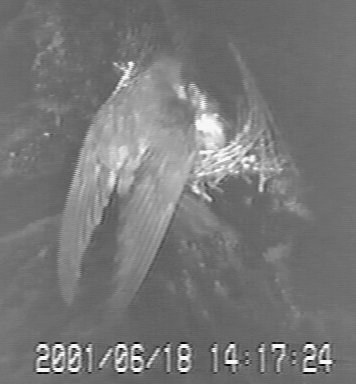


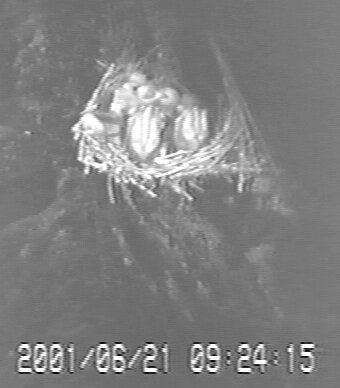


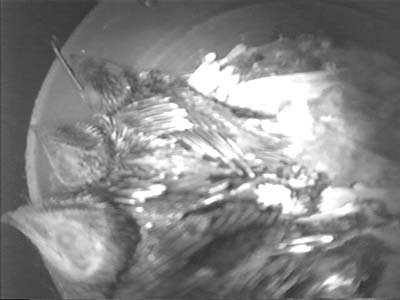

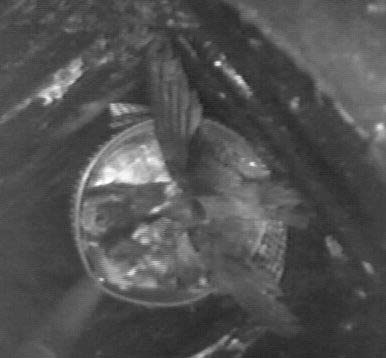
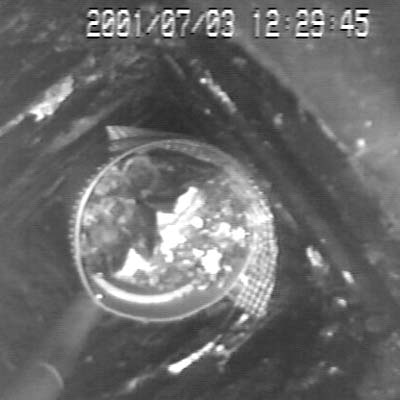
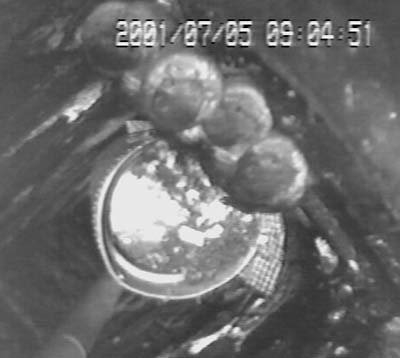






to 10' long and 2' wide.


each 20' ladder in half provided 4 of the 5 ten ft ladders needed to reach the top.


Grooves were cut across the plywood siding for better nest adherence.
Also, the planer marks run horizontally across the plywood sheets.


The more (instinctively) intelligent among us fly south for the winter.
The rest of us just await their return..